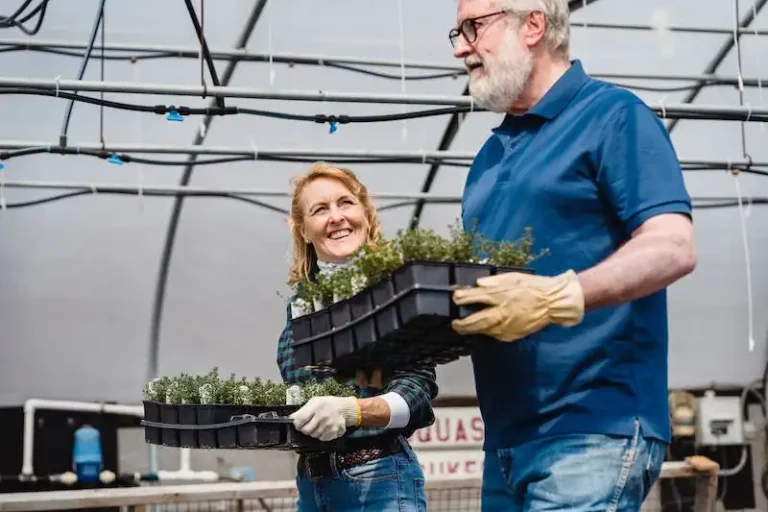Alocasia plants, also known as elephant ears, are popular houseplants that can add a touch of tropical beauty to any indoor space. With their large, textured leaves and unique foliage, they are sure to become a focal point in your home. In this guide, we will provide you with all the information you need to successfully grow and care for Alocasia plants.
First, let’s talk about potting. Alocasia plants prefer well-draining soils, so it is important to select a pot with drainage holes to prevent water from sitting in the bottom. Alocasia baginda, also known as the Alocasia “Dragon Scale,” has smooth, green leaves with prominent veins, while Alocasia micholitziana, also known as Alocasia “Frydek,” has dark green, almost black leaves with contrasting white veins.
To promote healthy growth, make sure to place your Alocasia plant in a location with plenty of bright, indirect light. However, be careful not to place it in direct sunlight, as this can cause the leaves to burn. Alocasia plants are native to the tropical regions of Southeast Asia, where they grow under the canopy of taller plants, receiving filtered light. Mimicking these conditions will ensure the best results.
Alocasia plants thrive in humid environments, so you can mist the leaves regularly or place a tray of water near the plant to increase the humidity level. Additionally, make sure to water your Alocasia plant thoroughly, allowing the top inch of soil to dry out between waterings. Overwatering can cause root rot, so it is important to find a balance.
When it comes to fertilizing, Alocasia plants are not heavy feeders, but they do benefit from regular fertilization. Use a balanced, all-purpose fertilizer once a month during the growing season to provide your plant with the nutrients it needs to thrive. However, be careful not to over-fertilize, as this can cause yellowing of the leaves.
If you notice any yellowing or damaged leaves, it is best to prune them away to promote new growth. Alocasia plants can be quite vigorous and can quickly become overcrowded, so it is important to regularly rotate the pot and tease out any bound roots. This will help your plant stay healthy and prevent it from becoming pot-bound.
Lastly, if you decide to grow your Alocasia plant outdoors, make sure to select a location that receives partial sun or dappled shade. Alocasia plants are not frost-tolerant, so it is important to bring them indoors before the first frost. They can also be grown as patio or porch plants, as long as they are protected from strong winds.
In conclusion, Alocasia plants are a stunning addition to any indoor space. With proper care and attention, they can thrive and bring a touch of tropical beauty to your home. Follow this ultimate guide to successfully grow and care for your Alocasia plants, and enjoy their broad, textured leaves for years to come!
How to Grow and Care for Alocasia
Alocasia plants, also known as Elephant Ears, are leafy tropical plants that can bring a touch of exotic beauty to any indoor or outdoor space. Their massive, arrowhead-shaped leaves and unique patterns make them popular among plant enthusiasts.
To ensure the proper growth and health of your Alocasia, it’s essential to provide them with the right care. Here are some tips to help you grow and care for Alocasia plants:
Light and Temperature: Alocasias thrive in bright, indirect light. Place them near a window where they can receive bright, filtered sunlight. Direct sunlight can scorch their leaves, so it’s best to avoid it. As for temperature, Alocasias prefer a warm and humid environment. Keep them away from cold drafts and maintain a temperature between 60-85°F (15-29°C).
Watering: Alocasias like to be evenly moist but not waterlogged. Let the top inch of soil dry out between waterings, and then water thoroughly, ensuring the water evenly penetrates the soil. Make sure to use well-draining soil to avoid waterlogged conditions that can lead to root rot.
Soil Type: Alocasias prefer a well-draining soil mix. You can use a mix of equal parts potting soil, peat moss, and perlite for optimal drainage.
Fertilization: Alocasias are heavy feeders, especially during the growing season. Use a balanced, water-soluble fertilizer once a month, following the package instructions. Alocasias respond well to fertilizers with higher nitrogen content to promote leaf growth.
Propagation: You can propagate Alocasias through division or by using rhizome cuttings. Divide the plant during repotting, ensuring each division has roots attached. Rhizome cuttings can be taken from healthy, established plants, making sure each cutting has at least one bud or shoot.
Pests and Diseases: Alocasias are generally resistant to pests, but they can occasionally encounter issues like spider mites, aphids, or mealybugs. Inspect the foliage regularly and treat any infestations promptly with insecticidal soap or neem oil. Alocasias are also susceptible to root rot if overwatered, so proper watering practices are crucial.
Companions: Alocasias make excellent companions to other tropical plants like ferns, calatheas, or peace lilies. Their foliage contrasts beautifully with other plants, creating a lush and vibrant display.
Caring for Alocasia plants can be rewarding for any gardener, whether they are beginners or experienced plant enthusiasts. Their unique foliage, quick growth, and exceptional beauty make them a must-have for any plant lover. Just remember to provide them with plenty of bright, indirect light, maintain proper watering practices, and fertilize them regularly to keep them thriving!
Watch Now How to Grow and Care for Alocasia Plants
If you are looking to add some color and textured foliage to your indoor or outdoor garden, Alocasia plants are a great choice. These plants are known for their deep green leaves and unique patterns which can add a focal point to any garden.
Here is a step-by-step guide on how to grow and care for Alocasia plants:
- Seedlings: Alocasia plants can be grown from seeds or through underground corms. If you are starting from seedlings, plant them in a well-draining potting mix.
- Repotting: Alocasia plants prefer to be slightly root-bound, so only repot them when needed. When repotting, use a pot that is slightly larger than the current one to give the plant room to grow.
- Yellowing leaves: Alocasia plants are sensitive to overwatering, so make sure to water them only when the top inch of soil feels dry. Yellowing leaves can be a sign of overwatering.
- Soil: Alocasia plants usually prefer rich and well-draining soils. You can also add organic matter to the soil to improve its fertility and moisture-holding capacity.
- Roots: Alocasia plants have fleshy roots that may protrude above the soil surface. This is natural and should not be a cause for concern.
- Toxicity: Alocasia plants are toxic to humans and pets if ingested, so be cautious when placing them in areas accessible to children and animals.
- Growth: Alocasia plants can grow up to 6 feet tall, depending on the variety. They are known for their strong and colorful foliage.
- Propagation: Alocasia plants can be commonly propagated through division or by taking stem cuttings. Both methods can be successful, depending on the plant’s growth rate and health.
- Moisture: Alocasia plants prefer a high level of moisture, as they are native to the rainforest environment. Try to mimic their natural habitat by providing frequent misting or placing a tray of water nearby.
- Light: Alocasia plants prefer bright, indirect light. While they can tolerate some direct sunlight, avoid placing them in full sun as it can scorch their leaves.
- Temperature: Alocasia plants thrive in warm and humid environments. They can tolerate temperatures as low as 60°F (15°C), but they may not survive freezing temperatures.
- Winter care: During the winter months, reduce watering and provide slightly cooler temperatures to allow the plant to rest. Keep an eye out for pests and diseases that may thrive in warm indoor environments.
By following these care tips, your Alocasia plants should thrive and bring beauty to your indoor or outdoor space. So go ahead and give these stunning plants a try!
Alocasia Care
ALocasia plants are known for their bold foliage and unique leaf textures. Proper care and maintenance are vital for ensuring their healthy growth. Here are some essential tips for caring for your Alocasia plants:
- Light: Alocasias thrive in bright, indirect light. Avoid placing them in direct sunlight as it can scorch the leaves.
- Watering: Alocasias love moisture, so keep the soil consistently moist but not waterlogged. Water thoroughly and allow excess water to drain. Watering should be done when the top inch of soil feels dry to the touch.
- Soil: Use a well-draining potting mix specially formulated for Alocasias. A mix of peat, perlite, and sand works well. Alocasias prefer slightly acidic soil with a pH level between 5.5 and 7.
- Temperature: Alocasias thrive in warm environments with temperatures ranging from 60 to 85 degrees Fahrenheit. Keep in mind that they’re tropical plants and don’t tolerate cold drafts or temperatures below 55 degrees Fahrenheit.
- Humidity: Alocasias love high humidity levels, so misting their leaves or placing them on a tray with water can help increase humidity levels. You can also use a humidifier.
- Fertilizer: Feed your Alocasia plants every four to six weeks during the growing season, using a balanced liquid fertilizer. Be careful not to over-fertilize, as this can cause burning of the roots.
- Propagation: Alocasias can be propagated by division or rhizome cuttings. When dividing the plant, ensure that each division has a healthy root system. Rhizome cuttings should be planted in a mix of peat and perlite.
- Pruning: Prune any yellow or shriveled leaves and remove any pests or infections. To encourage bushier growth, you can also prune the main stem slightly.
- Pests: Watch out for common pests like spider mites, aphids, and mealybugs. Inspect your plant regularly and treat any infestations promptly.
- Common Varieties: Some popular Alocasia varieties include Alocasia ‘Polly’, Alocasia ‘Frydek’, Alocasia ‘Stingray’, and Alocasia ‘Dragon Scale’. Each variety has its own unique leaf shape, texture, and colors.
- Extra Care: Alocasia leaves are known to cause skin irritation, so it’s important to handle them with care. If you have any irritations or allergies, it’s best to wear gloves while handling the plants.
By following these care instructions, you can ensure that your Alocasia plants thrive and display their vibrant foliage colors in your home or garden.



